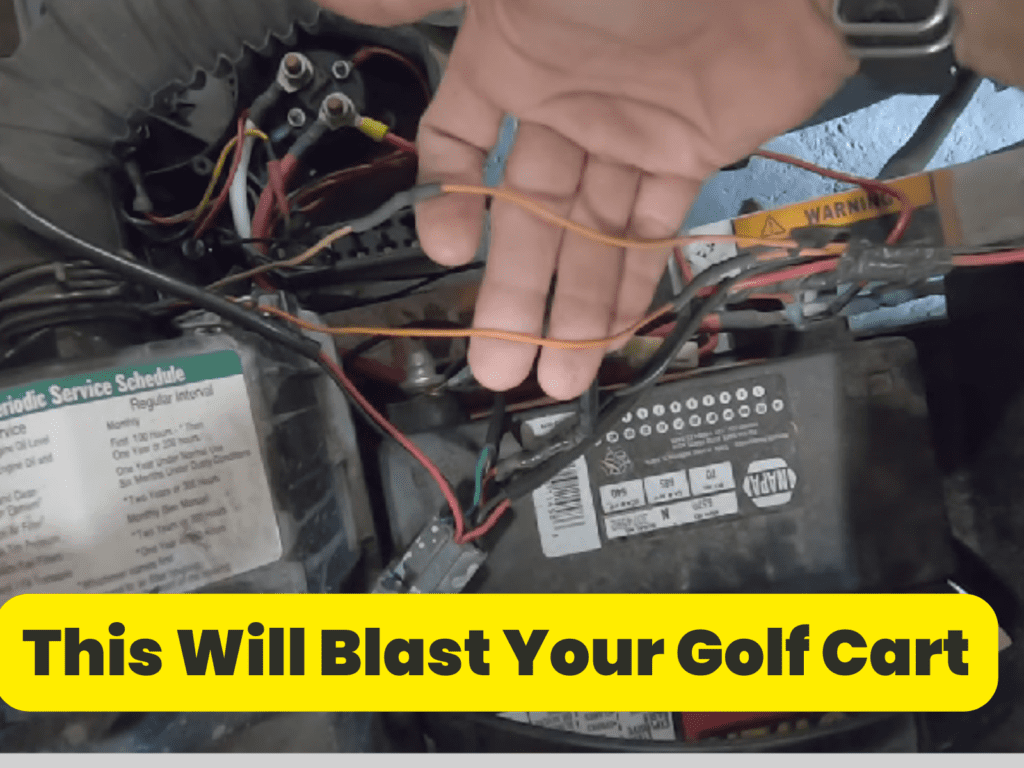Electric golf carts provide quiet and smooth transportation out on the links, with lower fueling costs compared to gas models. However, their driving range per charge often maxes out at around 30 miles while battery recharging takes hours.
If an aging battery is limiting the mileage or power of your trusty E-Z-Go, Club Car, or Yamaha golf cart, converting it from electric to gasoline operation can restore performance and extend drives up to 50 miles or more.
By replacing the electric motor and components with an integrated gas engine, fuel system and controls, handy DIYers can transform their electrics into fuel-efficient gas-powered carts suitable for cruising the neighborhood or campground.
This complete conversion guide covers how to evaluate cart compatibility, select an appropriate off-the-shelf engine kit, safely remove the old electric systems, tackle the installation and gas engine setup, and get your upgraded golf cart back on the road with its newfound range and driving character.
The short and direct answer is, it’s not practical. But let’s dive deeper.
But Should You Really Convert?
if you take my personal advice, I wont recommended you to convert it. here are some drawbacks of it…
One big drawback is losing the emissions-free environmental benefit of electric operation. Petrol engines emit hazardous emissions and greenhouse gases, contributing more to climate change than road mileage. Changing your cart from zero-emissions to fuel-burning.
Noise Increase Gasoline engines are louder than electric ones. Droning engine noise can bother regular operators and neighbours. Consider ambient noise levels for your driving destination.
Oil changes, belt repairs, fuel stabiliser storage, exhaust and ignition system maintenance, etc. are more complicated with a gas powerplant. For long-term users who don’t like engine repairs, the electric system is easier.
Costlier and less efficient The electric miles per kilowatt-hour are more efficient than the small petrol engines’ mpg. With growing petrol prices, operational costs may exceed electric car recharge costs throughout the lifetime.
Although range and charge times are variables, golf cart owners must consider if gas conversion is a good long-term investment based on their needs and preferences. Optimising battery range or infrastructure, or buying another electric cart for neighbourhood rides, may be better than altering their vehicle’s powertrain.
Before we explore this question further, understanding the key differences between electric and gas-powered golf carts can give us some context.
Differences between electric and gas-powered golf carts
- Fuel Source: The primary difference, obviously, rests in their fuel source. While gas-powered golf carts run on gasoline like a typical motor vehicle, electric golf carts utilize rechargeable batteries.
- Maintenance Needs: Gas golf carts typically require more maintenance than their electric counterparts. This includes oil changes, spark plug replacements, and other engine-related upkeep.
- Noise and Pollution: Gas carts tend to be louder than electric carts and also emit fumes, making them less eco-friendly compared to the quiet, zero-emission electric golf carts.
- Torque and Speed: Electric golf carts offer greater torque allowing for better uphill performance but gas golf carts often provide a higher top speed.
Can you then convert an Electric Cart to Gas?
Well, in theory it is possible to transform a cart into a gas-powered one. However, the process is quite intricate, expensive and time consuming. Unless you have expertise in mechanical engineering and sufficient financial resources to support the conversion procedure it may not be advisable for you to undertake this conversion on your own.
In summary, while it’s possible in theory to transform an electric cart into a gas-powered one, it̀ is generally not recommended due to time, cost, complexity factors and potential safety risks.
Reasons for Converting an Electric Golf Cart to Gas

Better Range and Power
One of the most significant advantages of switching an electric golf cart to a gas golf cart is the increased range and power. Electric golf carts often have a limited range and can soon run out of battery power, particularly when traversing steep terrain or carrying big loads. You may dramatically boost the cart’s range and power by changing it to petrol, allowing you to go greater places without worrying about running out of battery charge. This is especially useful for individuals who use their golf carts for longer excursions or in places where charging outlets are few.
Availability of Fuel
One more factor to take into account when considering the conversion of a golf cart to gas is the availability of fuel. While charging stations are becoming more common nowadays there may still be some areas where access to charging stations is limited or even unavailable. On the hand gas stations are much more widespread making it convenient to refill your gas powered golf cart whenever necessary. This easy access to fuel ensures that you won’t have to worry about being stranded in the middle of your golf game or outdoor activities due, to a lack of charging options.
Cost Considerations
Although electric golf carts tend to have operational costs than their gas powered counterparts they generally come with a higher price tag at the time of purchase. However if you already own a cart converting it to run on gas can be a cost effective alternative. Converting your existing cart is typically more budget friendly, than buying a brand new gas powered golf cart. Moreover gas powered carts often demand maintenance compared to electric ones, which can lead to additional long term cost savings.
Compatibility with Existing Infrastructure
Converting an electric golf cart to gas ensures compatibility with existing infrastructure. Many golf courses and recreational areas already have a well-established infrastructure in place to support gas-powered carts. This includes maintenance facilities, fueling stations, and service technicians who are familiar with gas-powered engines. By converting your electric cart to gas, you can easily integrate it into these existing systems and enjoy the same level of service and convenience as gas-powered cart owners.
Factors to Consider
If you own an electric golf cart and you’re considering converting it to gas, there are several points to ponder upon.
The first would be the feasibility of this change. Converting an electric motor to a gas motor is not an easy task. Make sure you take into consideration the potential costs, legalities, and complexity of the conversion.
The second point would be the gains. Would this change bring about any significant advantages in power, mileage, or usability? This is a question that needs thorough research before making your decision.
Evaluating the feasibility and advantages of converting an electric golf cart to gas
Feasibility: One important aspect to understand is that most golf carts aren’t designed to house gasoline engines, hence the conversion can get complicated. You’ll require specific technical knowledge plus a good deal of time, or else hire a professional for the task. This could make the conversion quite expensive.
Advantages: Considering advantages, a golf cart with a gas engine might exhibit better performance in terms of power and speed. Moreover, it can run longer on a single fill-up compared to an electric golf cart’s battery charge. Furthermore, refueling is faster than charging.
However, remember that gas engines are noisier and may also increase carbon footprint which contradicts environmental sustainability practices.
In conclusion, converting an electric golf cart to a gas one is feasible – but make sure to consider associated costs and potential benefits. Comparing these with your specific requirements will help in making an informed decision.
Evaluating Your Golf Cart & Needed Parts
A. Considering Model Year, Voltage, and Motor Size for Compatibility
When selecting parts for converting your electric golf cart to gas, the key specifications to note about your existing cart include:
- Model Year – The cart design and dimensions can vary across model years, even within the same make/model. This affects component fitting.
- Voltage System – Most are 36V or 48V. Higher voltage systems need a gas engine with higher horsepower output.
- Motor Size – Measured in hp or kW. Choose an engine with ~1.5x the motor power to match prior performance.
You also need to account for the cart’s physical size, axle configuration, wheel/tire dimensions etc. These impact the engine mounts and parts fitting.
B. Engine Options: 2-Stroke vs 4-Stroke Gasoline Engines
The two main engine categories suitable for golf cart conversion are:
2-Stroke Engines:
- Lighter, more powerful for their size
- Require pre-mixed fuel with oil
- Noisier, higher emissions
4-Stroke Engines:
- Heavier for equivalent power
- Use plain gasoline
- Quieter and lower emissions
- Higher lifespan and lower maintenance
In either case, the engine horsepower should exceed your existing electric motor rating. Some guidelines:
| Cart Motor Power | Suitable Gas Engine |
|---|---|
| 36V @400W | approx. 6.5hp |
| 36V @800W | approx. 13hp |
| 48V @500W | approx. 10hp |
| 48V @1000W | approx. 16hp |
Step-by-Step Conversion Process

Assessing Feasibility
It is critical to analyse the possibility of converting your unique electric golf cart to gas before commencing the conversion procedure.
The age and condition of the cart, the availability of conversion kits or components, the needed changes, and any potential legal or warranty consequences are all factors to consider. Assessing feasibility can assist you in determining whether changing to petrol is a realistic choice for your particular scenario.
Researching Conversion Kits
After determining that converting to petrol is a viable option, the following step is to study and purchase an appropriate conversion kit.
Conversion kits are available from a variety of vendors, each with their own set of components and instructions. It is critical to select a kit that is compatible with the brand and model of your golf cart and has all of the necessary components for a successful conversion.
Gather Necessary Tools and Equipment
Before you begin the conversion process make sure to gather all the tools and equipment you’ll need. This may involve hand tools like wrenches, sockets and screwdrivers as well as any specialized tools required for specific tasks.
By having all the tools at hand you’ll be able to smoothly carry out the conversion and be ready, for any obstacles that might come your way.
Removing Electric Components
Begin the conversion process by removing the electric components from the golf cart. This typically involves disconnecting and removing the electric motor, battery pack, controller, and charger. Carefully label and retain any components that may be reusable or necessary for future electrical adjustments.
Modifying Chassis
Next, modify the chassis of the golf cart to accommodate the gas engine and other necessary components.
This may involve drilling new holes, fabricating mounting brackets, or reinforcing certain areas of the chassis. The extent of modification required will depend on the specific conversion kit and gas engine being installed.
Installing Gas Engine
After finishing the modifications to the chassis follow the instructions provided by the manufacturer to properly install the gas engine.
This process may include attaching the engine to the chassis connecting it to the transmission and securely fastening it in position. It is essential to ensure an installation, for both safety and optimal engine performance.
Adapting Fuel Delivery System
After the gas engine is installed, adapt the fuel delivery system to accommodate the gas-powered engine. This includes installing a fuel tank, fuel pump, and fuel lines. Ensure all connections are secure and free from leaks to prevent any fuel-related issues.
Wiring and Electrical Adjustments
With the gas engine in place, make the necessary wiring and electrical adjustments to ensure the electrical system functions properly with the new gas engine.
This may involve rewiring components, adapting the ignition system, and connecting the battery to the appropriate electrical components. Take caution and follow the instructions provided by the conversion kit manufacturer.
Brake and Suspension Enhancements
Consider making any necessary brake and suspension enhancements. Converting to a gas engine may introduce increased speed and power, requiring upgraded brakes and suspension components to ensure safe and controlled operation.
Consult with professionals or refer to conversion kit instructions to determine if any brake or suspension modifications are recommended.
Testing and Troubleshooting
After the conversion process is complete, it is essential to thoroughly test the gas-converted golf cart to ensure everything is functioning correctly.
Start by checking for any fuel leaks, verifying proper engine operation, and assessing the responsiveness of the vehicle. Additionally, test the electrical systems and ensure the safety features, such as brakes and lights, are working as intended. Address any issues or malfunctions promptly to ensure a safe and reliable gas-converted golf cart.
RELATED: How Far Can An Electric Golf Cart Travel On A Single Charge?
Necessary Parts and Equipment
Many people who enjoy activities and golf may find the concept of transforming their electric golf cart into a gas powered one quite fascinating. However is it truly achievable to make this conversion? The answer is affirmative although it necessitates an amount of expertise, effort and resources. Lets discuss the components and equipment you’ll need for this endeavor.
Identifying the components required for the conversion
Gas Engine: You’ll need to replace your electric engine with a compatible internal combustion engine, usually used in automobiles or utility vehicles.
- Exhaust System: Your new engine will require an entire exhaust system to release waste gases properly.
- Fuel System: A fuel tank, fuel lines, and a fuel pump will be needed to feed gasoline into your new gas engine.
- Cooling System: The radiator, cooling fans, hoses, fluids etc., will be necessary to cool the internal combustion engine.
- Transmission System: A transmission system, including a clutch and drive shaft, help to transmit power from the engine to the wheels of your golf cart.
Note: It’s essential to understand that this conversion could void any warranty on your golf cart, and can also be more expensive than simply buying a new gas-powered golf cart. Moreover, availability and acquisition of parts should also be taken into account while deciding on a conversion.
This table summarizes the key required parts:
| Necessary Components for Conversion | |
|---|---|
| 1 | Gas Engine |
| 2 | Exhaust System |
| 3 | Fuel System |
| 4 | Cooling System |
| 5 | Transmission System |
Remember, converting an electric golf cart into a gas-powered one isn’t a simple task. If you’re not confident about performing this conversion yourself, it’s best to consult with a professional or use an experienced mechanic service.
DIY vs. Professional Conversion
The world is increasingly moving towards a greener future. However, you might find yourself questioning: Can I convert my electric golf cart into a gas-powered one?
Surprisingly, the answer is yes. But very importantly, there are two main ways to go about it: DIY (Do-It-Yourself) or seeking professional assistance.
Pros and Cons of DIY Conversion versus Seeking Professional Assistance
DIY Conversion
- Pros
- Cost-Friendly: As you might expect, undertaking the conversion by yourself means you save on labour costs.
- Satisfaction: The thrill and fulfillment of successfully converting an electric golf cart to gas can be quite exhilarating.
- Cons
- Risks: The conversion process can be complex, which increases the chances of errors that could affect the performance and safety of your golf cart.
- Time-Consuming: If you’re not experienced in this field, the conversion project could take more time than you expect.
Professional Assistance
- Pros
- Safety & Reliability: A professional has the required knowledge and skills, increasing the likelihood of a quality conversion that retains the golf cart’s functionality and safety features.
- Time-Efficient: Handing over the task to a pro means faster completion. The time you’d spend doing it yourself can be better invested elsewhere.
- Cons
- Costly: Engaging a professional service comes with associated costs which are definitely higher than a DIY approach.
In conclusion, whether you choose to change your electric golf cart to gas by yourself or through professional help depends on your budget, skill level, and availability of spare time for such a project.
Legal and Safety Considerations

The process of converting an electric golf cart to gas is not only about mechanical alterations. It also envelops adhering to legal principles and safety measures. Let’s delve into what these involve.
Understanding the regulations and safety measures associated with gas-powered golf carts
Know Your Local Laws: First and foremost, you must familiarize yourself with your local and state regulations toward gas-powered golf carts. Some jurisdictions might have restrictions or standards for emissions, noise level, or even general usage of gas-powered carts. Check with the relevant authorities before you start on your conversion project.
Preserve Safety Measures: Gas engines generate heat and can be a potential fire hazard if not handled correctly. Always ensure any alterations made don’t compromise the established safety protocols of your cart. Better yet, get professional advice to ensure all safety measures are in place.
Maintain Insurance: Converting from electric to gasoline could potentially cause challenges with your insurance company. Be sure to notify them about the changes made to avoid policy cancellation or claim denial in case something goes awry.
Additionally, there are technical aspects you should be aware of:
- Golf carts designed for electric operation have different weight distribution and chassis design compared with gas counterparts. These components might need modification to accommodate a gas engine optimally.
- The existing braking system might also need upgrading to handle the new speeds effectively.
- Note that adding a gas engine increases the overall weight of the cart affecting its performance and stability, especially in rough terrain or slopes.
For a successful conversion project, it’s crucial to consider every angle beyond just the engine swap. Throw in thorough research, plan realistically, and when in doubt, rely on professionals with proper training and expertise.
Cost and Maintenance
When considering whether you can convert an electric golf cart to gas, understanding the cost and maintenance requirements is critical. The decision to shift from an electric cart to a gas one shouldn’t be taken lightly. It involves higher operation and maintenance costs that shouldn’t be overlooked.
Nonetheless, yes you can convert an electric golf cart to gas, but how financially sound and sensible is this?
The scope of the conversion process and its implications are extensive. And considering the numerous components involved in a golf cart: engine, batteries, wiring, controllers—it is definitely a task that requires careful consideration.
Evaluating the financial implications and maintenance requirements of a converted gas-powered golf cart
Cost: A conversion from electric to gas can be costly. The conversion requires an entirely new engine block which sometimes comes with a hefty price tag.
1.Engine: Switching the engine type will demand some heavy mechanical work on the golf cart’s bodywork.
2.Battery: Since gas-powered carts do not need the battery pack necessary for electric carts, it won’t have to be replaced every few years.
Maintenance: Aiming for a converted gas-powered golf cart also means higher maintenance needs.
1.Tune-ups: You will have to perform regular tune-ups on your new gas engine.
2.Fuel: You need to be ready for continuous fuel expenses which aren’t needed for electric carts.
In summary, it’s possible, but not necessarily inexpensive or simple, to convert an electric golf cart to a gas one. Thus, it’s essential to weigh these factors against your budget and ability to handle increased maintenance work before diving into such a project.
Conclusion
Electric golf carts are excellent for short trips and quiet rides. But what if you desire more power or autonomy that a gas cart provides? The question then becomes: can an electric golf cart be converted to gas?
I present to you the answer: Yes, it’s technically feasible but comes with unique challenges!
Summary of key points and recommendations for converting an electric golf cart to gas
Is it recommended?
Converting electric golf carts to gas is not typically advisable. It often has higher costs and requires extensive knowledge of their mechanical workings.
Considerations:
- Mechanical Complexity: This process involves removing the entire electric powertrain and replacing it with a combustion engine. You may also need additional parts like the exhaust system, fuel tank, and cooling measures, leading to increased difficulty.
- Cost-Effectiveness: Conversion requires substantial investment which can exceed the cost of buying a new gas-powered golf cart.
- Legal Constraints: Some legal constraints may prevent you from using a converted golf cart in certain locations. Therefore, always check your local laws before undertaking this task.
Alternatives:
Instead of undergoing such conversion, consider these alternatives:
- Purchasing a Gas Cart: If power is your primary concern, purchasing an original gas-powered golf cart could save you time, effort, and potentially money.
- Upgrading Your Electric Cart: Upgrade your electrical system within the existing infrastructure to improve performance.
In conclusion, while converting an electric golf cart to gas is theoretically possible, it typically isn’t practical due to the costs and complexity involved. Weighing up the pros and cons before deciding whether to convert your electric cart or seek out other ways to meet your needs is vital.
Remember, golf cart manipulation might involve technical complexity and safety concerns, so always consult with professionals if necessary.
Frequently Asked Questions (FAQs)
How much does it cost to convert?
Conversion kits range from $500 to $3000, not including tools, equipment, and expert help if needed. Research pricing from multiple suppliers.
Can any electric golf cart be converted?
Most can be converted, but compatibility varies by cart model and availability of conversion kits. Analyze your specific cart before proceeding.
Does it void the manufacturer warranty?
Likely yes – modifying equipment commonly violates warranties, so verify before converting.
What are the legal considerations?
Check regulations on licensing, registration, insurance, and municipal gas vehicle restrictions. Follow all laws.
Can the cart still operate electrically after converting?
No, the electric components are removed so only gas engine operation is possible after converting.
What kind of maintenance is required?
Routine maintenance like oil changes, filter replacements, engine inspections – similar to gas vehicles.
Is reversing the conversion possible?
Rarely, depending on modifications made. Consult experts on feasibility of reconverting to electric.

I’m Donna Weiss, and I am the proud writer behind the captivating content you’ll find on golfneedy.com. As an avid golfer and passionate writer, I have combined my two greatest passions to bring you an incredible golfing experience. Through my articles, I aim to provide you with valuable insights, equipment reviews, and updates on the latest tournaments. Whether you’re a seasoned golfer or just starting out on this exciting journey, I am here to guide you and share my expertise. Together, let’s explore the fascinating world of golf, uncovering new techniques, and enhancing our skills. Join me on this thrilling adventure as we elevate our game and embark on an exciting golfing journey. Read More




Very educating story, saved your site for hopes to read more!